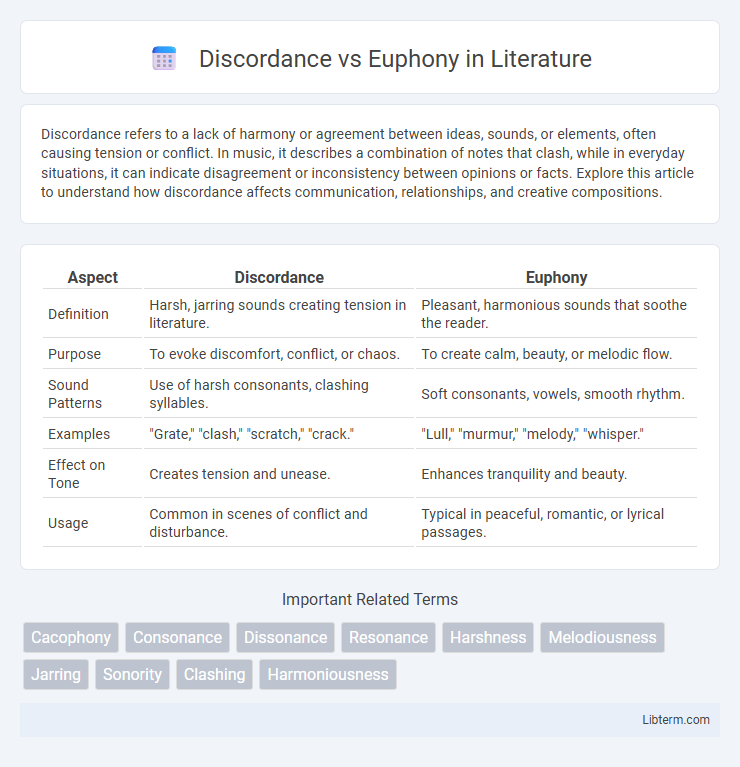Discordance refers to a lack of harmony or agreement between ideas, sounds, or elements, often causing tension or conflict. In music, it describes a combination of notes that clash, while in everyday situations, it can indicate disagreement or inconsistency between opinions or facts. Explore this article to understand how discordance affects communication, relationships, and creative compositions.
Table of Comparison
| Aspect | Discordance | Euphony |
|---|---|---|
| Definition | Harsh, jarring sounds creating tension in literature. | Pleasant, harmonious sounds that soothe the reader. |
| Purpose | To evoke discomfort, conflict, or chaos. | To create calm, beauty, or melodic flow. |
| Sound Patterns | Use of harsh consonants, clashing syllables. | Soft consonants, vowels, smooth rhythm. |
| Examples | "Grate," "clash," "scratch," "crack." | "Lull," "murmur," "melody," "whisper." |
| Effect on Tone | Creates tension and unease. | Enhances tranquility and beauty. |
| Usage | Common in scenes of conflict and disturbance. | Typical in peaceful, romantic, or lyrical passages. |
Introduction to Discordance and Euphony
Discordance refers to a lack of harmony or agreement in sounds, often producing a harsh or jarring effect that draws attention to tension or conflict within a text. Euphony involves the use of harmonious, melodious sounds that create a pleasing and soothing auditory experience, enhancing the aesthetic appeal of language. Both concepts play crucial roles in literary and musical compositions by manipulating sound to evoke specific emotional responses or emphasize thematic elements.
Defining Discordance in Language and Sound
Discordance in language and sound refers to the intentional use of harsh, jarring, or clashing elements that create a sense of tension or discomfort. This technique disrupts the harmony of words or sounds, often evoking strong emotional responses or highlighting conflict within literary or musical compositions. Discordance contrasts sharply with euphony, which emphasizes smooth, pleasing, and melodious auditory effects.
What is Euphony? Meaning and Examples
Euphony refers to the harmonious combination of sounds that are pleasing to the ear, often achieved through the use of smooth, flowing consonants and vowels. This concept is commonly employed in poetry and prose to create a melodious auditory effect, exemplified by phrases like "mellow wedding bells" or "soft whispers of the wind." Euphony enhances the aesthetic quality of language by promoting a soothing and agreeable sound pattern that contrasts with the harshness of discordance.
Historical Perspectives on Discordance and Euphony
Historical perspectives on discordance and euphony reveal shifting cultural attitudes toward harmony and dissonance in music. In Western classical traditions, the Renaissance period emphasized consonance as the foundation of beauty, while the Baroque era began exploring controlled dissonance to evoke emotional tension. By the 20th century, composers like Arnold Schoenberg challenged traditional euphony by embracing discordance as a means of artistic expression and innovation.
The Role of Discordance in Artistic Expression
Discordance in artistic expression challenges conventional harmony by introducing tension and unexpected sound combinations that provoke emotional and intellectual responses. This deliberate use of dissonance enhances the depth and complexity of a piece, encouraging active engagement and highlighting themes of conflict or chaos. In contrast to euphony, which aims for pleasing and harmonious tones, discordance serves as a powerful tool for innovation and emotional authenticity in music, literature, and visual arts.
Euphony in Poetry and Prose
Euphony in poetry and prose refers to the use of harmonious and melodious sounds that create a pleasant and smooth auditory effect, enhancing the reader's experience. Writers employ euphonic techniques such as alliteration, assonance, and consonance to evoke emotions and reinforce the tone, making the text more engaging and memorable. In contrast to discordance, euphony fosters aesthetic pleasure and fluidity in language, contributing significantly to the artistic quality of literary works.
Discordance vs Euphony: Key Differences
Discordance refers to a lack of harmony or clash between sounds, creating tension or unpleasantness, whereas euphony denotes a pleasant, harmonious combination of sounds that is soothing to the ear. Discordance often involves jarring, dissonant tones used intentionally in music, literature, and speech to evoke strong emotions or highlight conflict. Euphony employs smooth, melodic, and flowing sounds to enhance aesthetic appeal and convey tranquility or beauty.
Psychological Effects: How Discordance and Euphony Influence Mood
Discordance, characterized by clashing or harsh sounds, often triggers feelings of tension, unease, or anxiety due to the brain's struggle to find harmony, which can heighten stress responses. Euphony, with its smooth and harmonious sound patterns, promotes relaxation and positive emotions by activating neural pathways associated with pleasure and calmness. These contrasting auditory experiences significantly shape mood regulation, influencing psychological states through their impact on emotional processing centers in the brain.
Modern Applications in Music and Literature
Discordance in modern music and literature often serves to evoke tension or unease, contrasting sharply with euphony, which creates harmonious and pleasing effects that enhance emotional resonance. Contemporary composers and writers strategically employ discordant chords or jarring word choices to challenge listeners' and readers' expectations, fostering deeper engagement and reflection. The interplay between discordance and euphony remains central in genres like experimental music and postmodern literature, where the balance between harmony and dissonance shapes thematic complexity and aesthetic innovation.
Conclusion: Striking a Balance Between Discordance and Euphony
Striking a balance between discordance and euphony enhances the emotional depth and texture of music or literature by blending unexpected sounds with harmonious tones. Incorporating elements of discordance introduces tension and complexity, while euphony ensures aesthetic appeal and soothing resonance. Mastery of this balance engages audiences, creating a dynamic and memorable sensory experience.
Discordance Infographic

 libterm.com
libterm.com